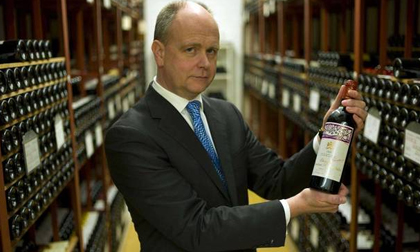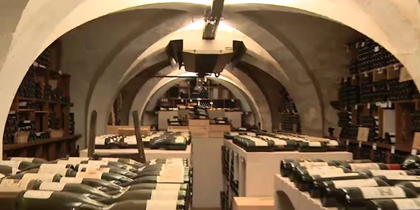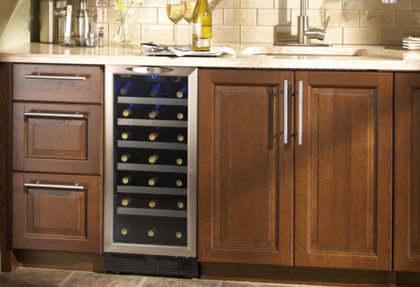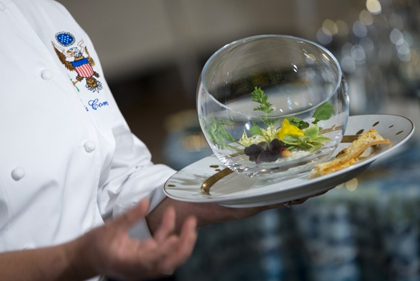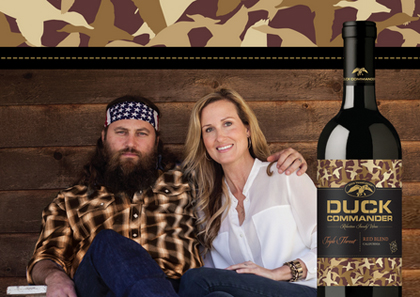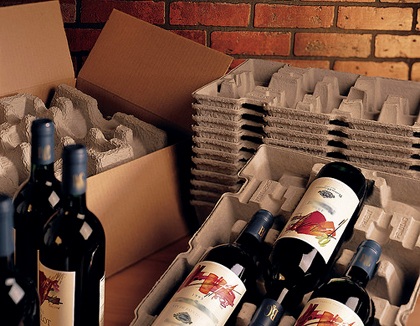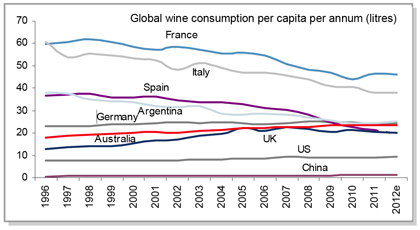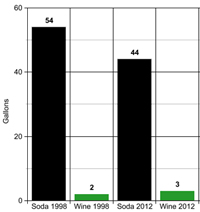Dr Vino's wine blog
wine talk that goes down easy
State wine cellars compared
Game time: see if you can correctly identify the photo of an official state wine cellar with the correct country, US, UK, and France.
Okay, okay, it’s photographic hyperbole — but the White House really doesn’t have a wine cellar to speak of. Downing Street (top) buys the wines on release and stores them for official occasions. Buckingham Palace has some terrific wines too as you may recall that when Obama went there on a state visit, the Queen uncorked some DRC and ’63 port. The Elysée Palace (middle) has an impressive cellar, as you might expect. The White House, by contrast, procures wines for state functions on-demand so rarely serves wines with much age on them.
The relative paucity of the White House wine cellar has its roots in our country’s love/hate relationship with alcohol: loved it so much that it became a political issue leading to Prohibition. While the shadow of Prohibition looms over the industry in the form of restrictions interstate shipments (among other things), the fact is that Americans are into wine now, as witnessed by instagram feeds or the fact that per capita consumption has increased for 20 consecutive years. So a big chunk of America would probably take pride in having some decent American wines slumbering in the White House basement.
How likely is that to happen? When pigs fly. The UK and France have both reduced their wine collections recently in the name of austerity. China introduced a ban on expensive alcohol at state banquets in the last quarter of 2011. And with an economy that’s not exactly firing on all cylinders here, there’s no way the White House would engender criticism for that kind of expenditure. Still, an American wine lover can but dream. Maybe, as a matter of national pride, Bill Koch could endow the White House with a starter collection of well-vetted wines from his cellar? Read more…
Wines for tonight’s state dinner: wine world shrugs
Breaking from tradition, the White House announced the wines to be served at tonight’s state dinner honoring President Francois Hollande and Madame–oh nevermind. So instead of engaging in subterfuge or speculation, we have the list. Here they are: Read more…
Napa Valley’s next generation of deer hunters, Porsche racers
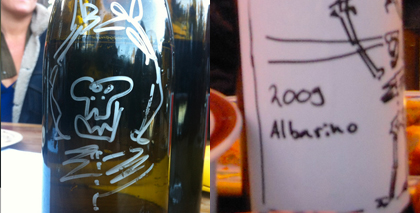 The SF Chronicle has a piece on the next generation of Napa Valley vintners. Here’s a snippet of what they’re up to:
The SF Chronicle has a piece on the next generation of Napa Valley vintners. Here’s a snippet of what they’re up to:
Young, ambitious and eco-friendly, with hobbies like deer hunting and Porsche racing, the next generation of California’s wine heirs is coming of age…
Ah, yes, eco-friendly Porsche racing! Funny, with this lot, you think they’d be Scions. Anyway, there’s more:
[Loren] Trefethen had been watching TED talks and attending Summit Series events, invite-only weekend escapes at a private ski resort, and he decided to host his own event series. The Trefethen Table, as he calls it, is a dinner series curated by Trefethen and Hebb. Guests – like Gary Friedman, the CEO of Restoration Hardware, and Ido Leffler, the founder of SayYes – sit around an enormous tabletop and discuss previously arranged topics, like the art of conversation, the ocean, health and “the paradox of density.”
And now he wants to make a reality TV show out of these talks.
Janet Viader: “We get together once a month, and there’s some laughing and joking. Every now and then it’s a bitch-fest about working with family.”
“Alex Kongsgaard works for his family’s winery and on the side makes a line of wines he calls Skeletons vs. Robots (an Albarino and a Zinfandel). He draws the labels himself with a Sharpie.”
“Will Harlan came home to Napa after trying his hand at a price comparison startup. In October, he debuted Mascot, a cheaper version of his family’s high-end wine (Harlan wines can go for $750 to wine club members; the Mascot costs $75).”
So much win! Check out the full article for an inside look at this rare breed.
Duck Commander wines and “yuppie folks”
“Yuppie folks ain’t the only ones who can enjoy good wine.”
This is one of the most important sentences of the year about American wine consumption as it appeared on People.com. I’m not even sure who the guy who said it actually is. But he is apparently hunts ducks on TV.
Yes, he’s also talking his own book since he now has a wine called Duck Commander. Look at it–it has camo on the labels! Truly, a beauty to behold.
Is it a wine that wine geeks will sip and cherish? Does it speak of a certain vineyard? No and no. But that what makes it awesome. It’s Bubba wine from a God-fearing, TV family (the Robertson duck “dynasty”) that sells for under $10 a bottle. Duck Commander wines and it’s ilk are just what America needs to keep per capita consumption rising for a twentieth consecutive year.
The only thing missing is the suggestion to serve it in redneck wine glasses.
Schumer backs wine-by-mail, but not enough
Charles Schumer of New York wants the US Postal Service to be able to ship wine and beer. The number three democrat in the Senate made comments this week to roll back a ban on wine and beer shipping that dates to 1909. He calls it a “win win win,” since it would benefit producers (in NY and elsewhere), consumers and the USPS. Schumer argued that the USPS could gain $225 million in revenues from such shipping, largely because it could offer flat rate shipping at lower rates than FedEx and UPS.
Shipping wine by mail is long overdue. In fact, I suggested this for the USPS last year, but since Schumer’s words carry more weight in Washington, I’m glad he’s reached the same conclusion.
However, it doesn’t go far enough. According to The Leader, a paper in Corning, Schumer’s proposal would only permit shipping from wineries (or breweries) to consumers. It makes sense to only give businesses the right to ship since they could put in place the proper age verification mechanisms for recipients. But only allowing wineries makes the mistake of excluding retailers. While we will take what we can get, if Schumer really wants to make this a “win” for consumers and the USPS, his proposals should include the right for wine shops to ship via the mail too. Not only do wine shops offer imported wines, which account for a third of wine sales in the US (and more in NYC, I’d venture to say), but shops often have better pricing than wineries. This, of course, is why Schumer would not want to include retailers. Consumers would obviously rejoice but so would the USPS since their anticipated revenue from wine could swell to $350 million to reflect the share of imported wine in the marketplace.
A final point: if the USPS shipped wine, it would greatly highlight the 39 recalcitrant state governments that still prohibit retailers from out of state to ship. While Schumer is challenging outdated drinks shipping laws, why not put an end to that one too.
Cue the bogeyman: world wine shortage!
Halloween always brings a lot of scaaaaaary stories. But the biggest bogeyman out there in wine news today is the story that the world is running out of wine.
Morgan Stanley’s Australian unit has published a report suggesting that global demand risks swallowing the world’s wine. Time to unleash a tsunami of chart-heavy posts and breathless news coverage!
In short, Morgan Stanley’s 78-page report makes the argument that production has fallen through various uprooting schemes in the EU, consumption has risen, and a 600 million case surplus in 2004 has swung to only a 1 million case cushion now.
However, Paul Franson points out that the fear is overblown since Morgan Stanley is the odd one out. It’s worth flagging his account over at Wines & Vines because Franson not only has some good figures but also gets some good quotes. Consider this one from Rabobank’s Stephen Rannekleiv: “It’s worth asking: If the market is so incredibly tight, why are bulk wine prices moving lower in most major regions of the world?” (He has more sanguine analysis about the market and hints at lots of under-the-table activity, adding “buying Spanish bulk wine and selling it as French bottled wine is a great business model.”)
The OIV forecasts an 8% rise in wine production this year. And Silicon Valley Bank’s Rob McMillan told the SF Chronicle that “Morgan Stanley’s report is just wrong,” citing a dearth of tank space for inventorying wine, among other factors.
Two things are happening here. First, there’s a ton of bulk wine in the world, admittedly less than there was a few years ago. But there was so much wine being produced that even AOC wine was being distilled into ethanol. Getting rid of wine that’s being made into a fuel additive is not exactly something for a wine consumer to lose sleep over. What is worrisome are the severe weather in places like Burgundy this summer, which will cause scarcity and drive prices higher. But this has absolutely nothing to do with the “wine lake” and distillation end of the market.
Second, many media outlets have picked up this story and run with the “shortage” angle. I know this is a spooky time of year, but praying on the fears of wine drinkers in this issue is unnecessary and short-sighted.
TTB shutdown means wine label slowdown
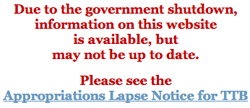 The federal government has shut down “nonessential” services as of today. Surprisingly, that means that the federal agency that regulates the wine industry is also largely shut down. This is surprising because the agency collected $26 billion in revenues for the government–you’d think they would want to keep that flowing.
The federal government has shut down “nonessential” services as of today. Surprisingly, that means that the federal agency that regulates the wine industry is also largely shut down. This is surprising because the agency collected $26 billion in revenues for the government–you’d think they would want to keep that flowing.
I spoke with a staffer at the TTB a few weeks ago while I was writing a story about wine label art. In the course of our conversation, he told me that the agency has experienced a surge in requests for label approvals. When they were formed ten years ago, they received 89,000 requests for label approvals whereas today they get 152,000 label requests. A 40% growth in wineries and a 60% rise in brewers have driven the surge. (Meanwhile, because of budget cuts, their headcount has been reduced from 520 to 471 over the same period.) I also spoke with some vintners who complained that the label approval process had slowed this year in the wake of the sequester. And now with the shutdown it will have ground to a halt.
Whenever TTB officials return to work they will have a ton of wine labels awaiting their review. The whole situation is enough to drive one to drink…
Before the shutdown occurred, the TTB did take a preliminary step to approving 11 new AVAs within the existing Paso Robles AVA.
Chart of the day: soda down, wine up
Americans love soda so much that we drink 44 gallons a head last year. But soda sales have slowed, as Americans drank 52 gallons of soda in 1998. So that’s a decline of 18%. Even though that change hasn’t been reflected entirely in America’s waistlines, the secular decline has led to some to argue that “peak soda” is over.
Of course, we’re drinking a lot of other things such as bottled water, coconut water (!), and the juice of pomegranates and acai berries. For beer, the consumption arrow is pointed down (and sentiment is in free-fall). But wine consumption per capita has risen every year since 1993.
So there you have the current score: soda, 44 gallons, red arrow; wine, 3 gallons, green arrow.
Oh, and for a bonus chart of the day, check out the latest poll data from Gallup. They show that Americans of all ages are more into wine than 20 years ago. Only 14 percent of the youngest drinkers then liked wine as their preferred drink (compared to 71 percent who like beer); 29 percent of that cohort now says wine is their preferred drink (with only 43 percent liking beer the most). Young people today like wine twice as much as they did then. And people over 50 don’t really like beer.
